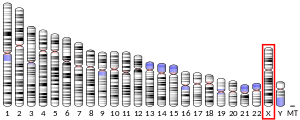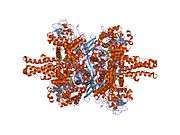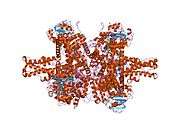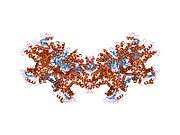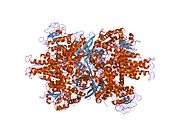GLUD2
Glutamate dehydrogenase 2, mitochondrial, also known as GDH 2, is an enzyme that in humans is encoded by the GLUD2 gene.[3][4][5] This dehydrogenase is one of the family of glutamate dehydrogenases that are ubiquitous in life.
| GLUD2 | |||||||||||||||||||||||||
|---|---|---|---|---|---|---|---|---|---|---|---|---|---|---|---|---|---|---|---|---|---|---|---|---|---|
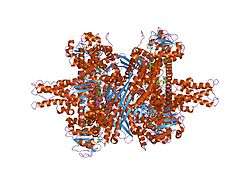 | |||||||||||||||||||||||||
| Identifiers | |||||||||||||||||||||||||
| Aliases | GLUD2, GDH2, GLUDP1, glutamate dehydrogenase 2 | ||||||||||||||||||||||||
| External IDs | OMIM: 300144 HomoloGene: 115647 GeneCards: GLUD2 | ||||||||||||||||||||||||
| |||||||||||||||||||||||||
| |||||||||||||||||||||||||
| Orthologs | |||||||||||||||||||||||||
| Species | Human | Mouse | |||||||||||||||||||||||
| Entrez |
| ||||||||||||||||||||||||
| Ensembl |
| ||||||||||||||||||||||||
| UniProt |
| ||||||||||||||||||||||||
| RefSeq (mRNA) |
| ||||||||||||||||||||||||
| RefSeq (protein) |
| ||||||||||||||||||||||||
| Location (UCSC) | Chr X: 121.05 – 121.05 Mb | n/a | |||||||||||||||||||||||
| PubMed search | [2] | n/a | |||||||||||||||||||||||
| Wikidata | |||||||||||||||||||||||||
| |||||||||||||||||||||||||
Function
Glutamate dehydrogenase 2 is localized to the mitochondrion and acts as a homohexamer to recycle glutamate during neurotransmission. The encoded enzyme catalyzes the reversible oxidative deamination of glutamate to alpha-ketoglutarate.[3]
gollark: It supports that actually.
gollark: Better how?
gollark: Oh dear. I need more effective counterbees.
gollark: Counterbees online.
gollark: This has been in place for a week or more.
References
- ENSG00000288118 GRCh38: Ensembl release 89: ENSG00000182890, ENSG00000288118 - Ensembl, May 2017
- "Human PubMed Reference:". National Center for Biotechnology Information, U.S. National Library of Medicine.
- "Entrez Gene: glutamate dehydrogenase 2".
- Shashidharan P, Michaelidis TM, Robakis NK, Kresovali A, Papamatheakis J, Plaitakis A (June 1994). "Novel human glutamate dehydrogenase expressed in neural and testicular tissues and encoded by an X-linked intronless gene". J. Biol. Chem. 269 (24): 16971–6. PMID 8207021.
- Shashidharan P, Clarke DD, Ahmed N, Moschonas N, Plaitakis A (May 1997). "Nerve tissue-specific human glutamate dehydrogenase that is thermolabile and highly regulated by ADP". J. Neurochem. 68 (5): 1804–11. doi:10.1046/j.1471-4159.1997.68051804.x. PMID 9109504.
Further reading
- Ross MT, Grafham DV, Coffey AJ, et al. (2005). "The DNA sequence of the human X chromosome". Nature. 434 (7031): 325–37. doi:10.1038/nature03440. PMC 2665286. PMID 15772651.
- Need AC, Keefe RS, Ge D, et al. (2009). "Pharmacogenetics of antipsychotic response in the CATIE trial: a candidate gene analysis". Eur. J. Hum. Genet. 17 (7): 946–57. doi:10.1038/ejhg.2008.264. PMC 2986499. PMID 19156168.
- Stelzl U, Worm U, Lalowski M, et al. (2005). "A human protein-protein interaction network: a resource for annotating the proteome". Cell. 122 (6): 957–68. doi:10.1016/j.cell.2005.08.029. hdl:11858/00-001M-0000-0010-8592-0. PMID 16169070.
- Burki F, Kaessmann H (2004). "Birth and adaptive evolution of a hominoid gene that supports high neurotransmitter flux". Nat. Genet. 36 (10): 1061–3. doi:10.1038/ng1431. PMID 15378063.
- Plaitakis A, Latsoudis H, Kanavouras K, et al. (2010). "Gain-of-function variant in GLUD2 glutamate dehydrogenase modifies Parkinson's disease onset". Eur. J. Hum. Genet. 18 (3): 336–41. doi:10.1038/ejhg.2009.179. PMC 2987208. PMID 19826450.
- Yang SJ, Cho EH, Choi MM, et al. (2005). "Critical role of the cysteine 323 residue in the catalytic activity of human glutamate dehydrogenase isozymes". Mol. Cells. 19 (1): 97–103. PMID 15750346.
- Yang SJ, Huh JW, Hong HN, et al. (2004). "Important role of Ser443 in different thermal stability of human glutamate dehydrogenase isozymes". FEBS Lett. 562 (1–3): 59–64. doi:10.1016/S0014-5793(04)00183-8. PMID 15044002.
- Kanavouras K, Borompokas N, Latsoudis H, et al. (2009). "Mutations in human GLUD2 glutamate dehydrogenase affecting basal activity and regulation". J. Neurochem. 109 Suppl 1: 167–73. doi:10.1111/j.1471-4159.2009.05914.x. PMID 19393024.
- Mastorodemos V, Zaganas I, Spanaki C, et al. (2005). "Molecular basis of human glutamate dehydrogenase regulation under changing energy demands". J. Neurosci. Res. 79 (1–2): 65–73. doi:10.1002/jnr.20353. PMID 15578726.
- Smith TJ, Schmidt T, Fang J, et al. (2002). "The structure of apo human glutamate dehydrogenase details subunit communication and allostery". J. Mol. Biol. 318 (3): 765–77. doi:10.1016/S0022-2836(02)00161-4. PMID 12054821.
- Plaitakis A, Spanaki C, Mastorodemos V, Zaganas I (2003). "Study of structure-function relationships in human glutamate dehydrogenases reveals novel molecular mechanisms for the regulation of the nerve tissue-specific (GLUD2) isoenzyme". Neurochem. Int. 43 (4–5): 401–10. doi:10.1016/S0197-0186(03)00028-7. PMID 12742085.
- Mastorodemos V, Kotzamani D, Zaganas I, et al. (2009). "Human GLUD1 and GLUD2 glutamate dehydrogenase localize to mitochondria and endoplasmic reticulum". Biochem. Cell Biol. 87 (3): 505–16. doi:10.1139/o09-008. PMID 19448744.
- Spanaki C, Zaganas I, Kleopa KA, Plaitakis A (2010). "Human GLUD2 glutamate dehydrogenase is expressed in neural and testicular supporting cells". J. Biol. Chem. 285 (22): 16748–56. doi:10.1074/jbc.M109.092999. PMC 2878061. PMID 20194501.
- Ahmed M, Forsberg J, Bergsten P (2005). "Protein profiling of human pancreatic islets by two-dimensional gel electrophoresis and mass spectrometry". J. Proteome Res. 4 (3): 931–40. doi:10.1021/pr050024a. PMID 15952740.
- Rosso L, Marques AC, Reichert AS, Kaessmann H (2008). "Mitochondrial targeting adaptation of the hominoid-specific glutamate dehydrogenase driven by positive Darwinian selection". PLoS Genet. 4 (8): e1000150. doi:10.1371/journal.pgen.1000150. PMC 2478720. PMID 18688271.
- Gerhard DS, Wagner L, Feingold EA, et al. (2004). "The status, quality, and expansion of the NIH full-length cDNA project: the Mammalian Gene Collection (MGC)". Genome Res. 14 (10B): 2121–7. doi:10.1101/gr.2596504. PMC 528928. PMID 15489334.
- Zaganas I, Kanavouras K, Mastorodemos V, et al. (2009). "The human GLUD2 glutamate dehydrogenase: localization and functional aspects". Neurochem. Int. 55 (1–3): 52–63. doi:10.1016/j.neuint.2009.03.001. PMID 19428807.
- Strausberg RL, Feingold EA, Grouse LH, et al. (2002). "Generation and initial analysis of more than 15,000 full-length human and mouse cDNA sequences". Proc. Natl. Acad. Sci. U.S.A. 99 (26): 16899–903. doi:10.1073/pnas.242603899. PMC 139241. PMID 12477932.
- Kanavouras K, Mastorodemos V, Borompokas N, et al. (2007). "Properties and molecular evolution of human GLUD2 (neural and testicular tissue-specific) glutamate dehydrogenase". J. Neurosci. Res. 85 (15): 3398–406. doi:10.1002/jnr.21576. PMID 17924438.
This article is issued from Wikipedia. The text is licensed under Creative Commons - Attribution - Sharealike. Additional terms may apply for the media files.
